June Acreage Report Bumps Corn Planted Acres up Slightly, Other Principal Crop Estimates Largely Unchanged
TOPICS
Wheat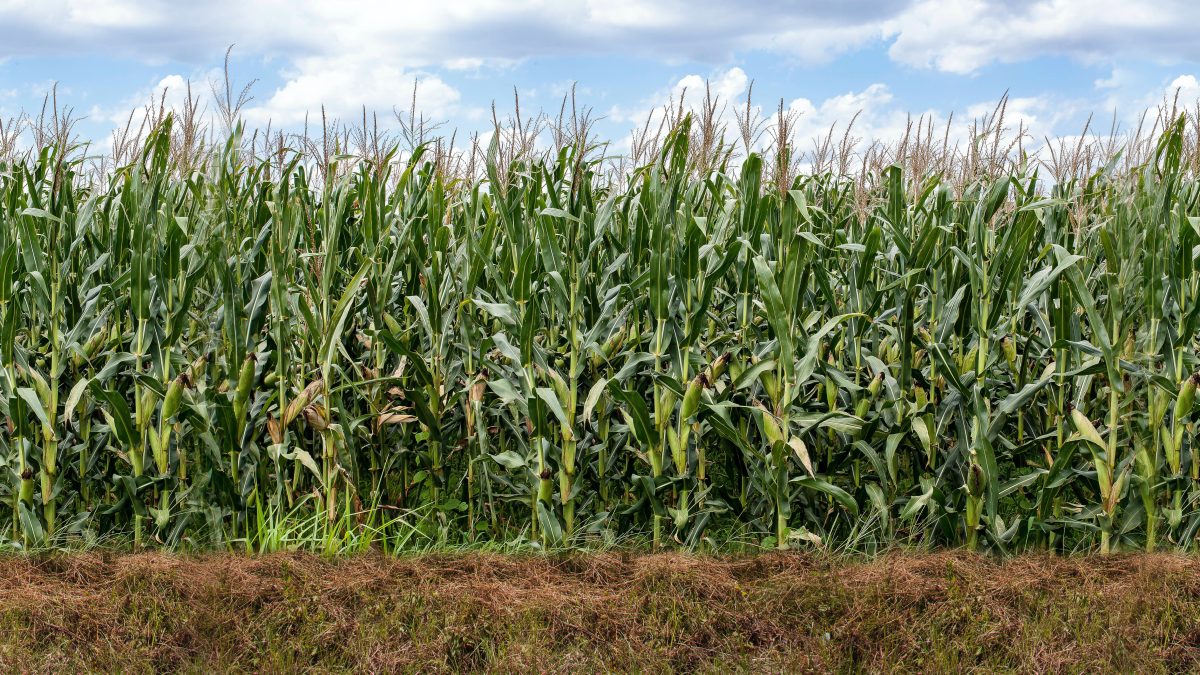
photo credit: Mark Stebnicki, North Carolina Farm Bureau
Shelby Myers
Former AFBF Economist
As an update to its March Prospective Plantings report, USDA released its June 30 Acreage report with revised acreage expectations for the upcoming crop year. For the 2021/22 crop year, USDA is estimating that corn planted area will be 92.7 million acres, up 2%, or 1.87 million acres, compared to 2020. This is an increase of 1.6 million acres from what was first reported for corn acres in March. Soybean planted acres remain at the 87.6 million acres reported in March, up 5% from 2020. Wheat planted acres are estimated at 46.7 million acres, up 5% from 2020, when 44.3 million acres were planted, but close to March estimates of 46.4 million acres. Cotton planted area for 2021 is estimated at 11.7 million acres, down 3% compared to last year, when 12.09 million acres were planted, and down from March estimates of 12 million acres.
Speculation leading up to this report was primarily centered around the potential for production acres shifting from soybeans to corn or vice versa, corn to soybeans. Today’s report indicates that farmers will increase combined corn and soybean acres from the 178.7 million acres first estimated in March to 180.3 million acres. This combined acreage total is just behind the 2017 peak of combined acres of 180.4 million, when farmers planted 90.2 million acres of each crop, but runs shy of estimates presented at the February Agriculture Outlook Forum, when USDA estimated farmers would plant a combined 182 million acres of corn and soybeans.
2021 Corn Planted Acres
Private sector pre-report estimates for corn planted acres called for big increases, with average estimates around 93.7 million acres of planted corn, but yesterday’s report indicates those estimates were too high. Iowa leads the way in corn acres planted with 13.1 million acres, a decrease of 4% compared to 2020, when Iowa farmers planted 13.6 million acres of corn. Illinois follows with 11.2 million acres of corn planted, down 1% from 2020 when Illinois farmers planted 11.3 million acres. Nebraska farmers have planted 9.7 million acres, down 5% from 2020, when they planted 10.2 million acres of corn. North Dakota is expected to have the largest increase of corn planted acres -- 85%, with 3.6 million acres in 2021, compared to 1.95 million acres in 2020. Arizona has the second-largest increase of corn planted acres -- 27%, going from 75,000 acres of corn in 2020 to 95,000 acres of corn in 2021. Mississippi has the third-largest increase --25%, rising from 510,000 acres in 2020 to 640,000 acres in 2021. USDA estimates 2.1 million acres of corn are still left to be planted, down 3% compared to this time last year, when 2.2 million acres of corn were still left to be planted.
Figures 1 and 2 highlight USDA’s 2021 corn acres planted and the year-over-year change from 2020.
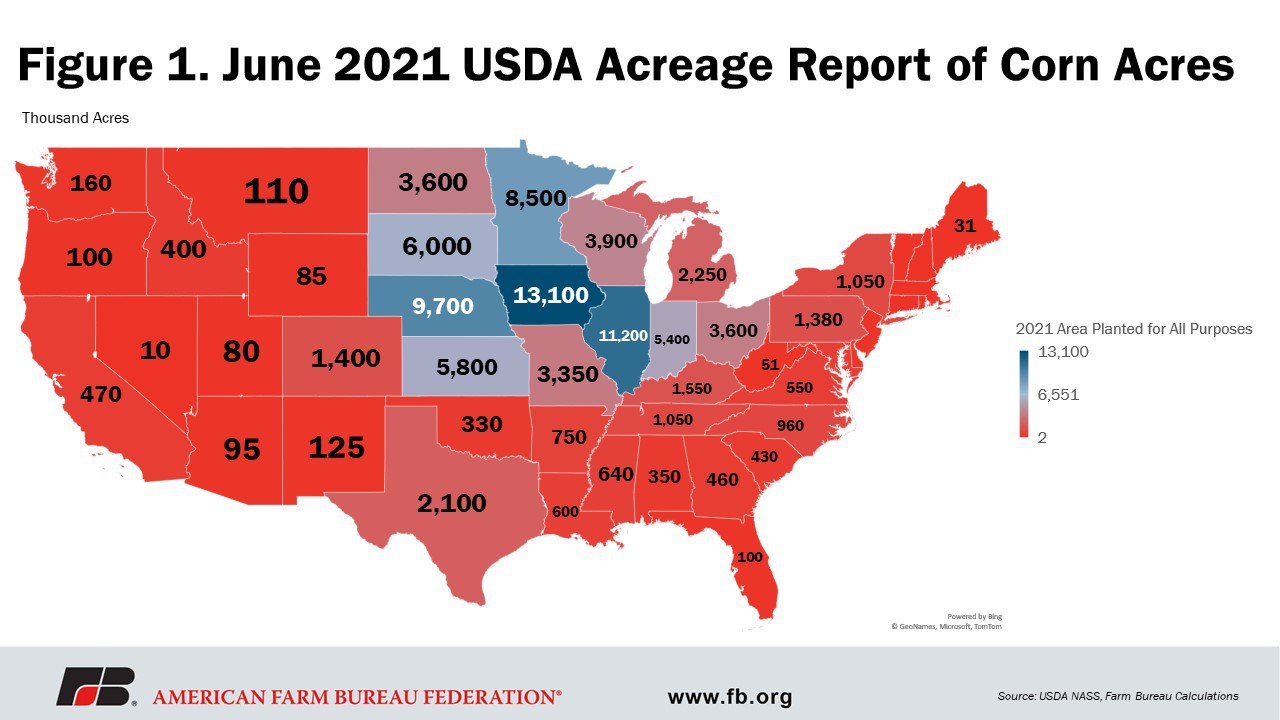
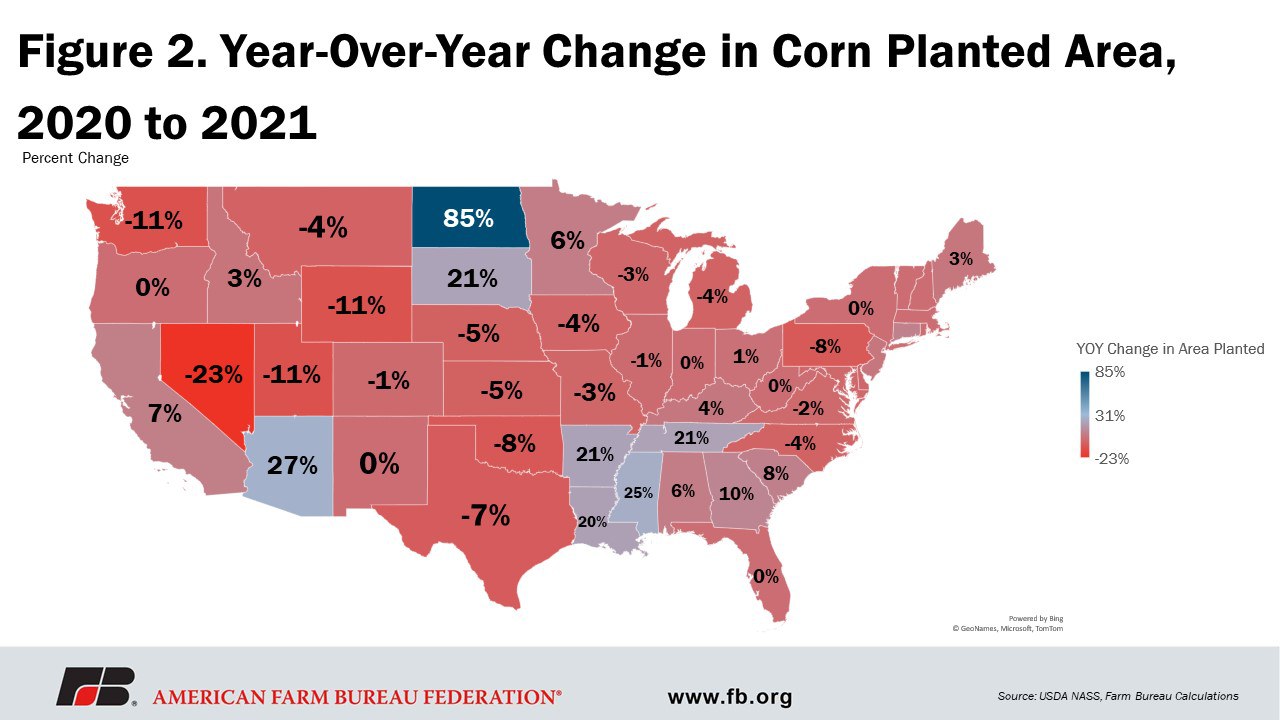
2021 Soybean Planted Acres
Ahead of the June report, private sector analysts estimated soybean planted acres would jump slightly, with the average analyst expectations coming in at just under 89 million acres of soybeans planted. However, yesterday’s report shows soybean planted acres holding steady at 87.6 million acres, as reported in March. Illinois is expected to lead the country in planted soybean acres with 10.7 million acres, an increase of 4% compared to 2020 when Illinois farmers planted 10.3 million acres. Iowa follows with 9.9 million acres of soybeans planted, up 5% from 2020, when Iowa farmers planted 9.4 million acres. Minnesota farmers have an estimated 7.7 million acres of soybeans planted, which is up 4% from 2020 when 7.4 million acres were planted. Georgia is expected to have the largest increase in soybeans planted -- 30% -- going from 100,000 acres in 2020 to 130,000 acres in 2021. Texas has the second-largest increase -- 29% -- going from 120,000 acres of soybeans planted in 2020 to 155,000 acres in 2021. The third-largest increase is expected in South Carolina –26% -- going from 310,000 acres in 2020 to 390,000 acres in 2021. USDA estimates 9.8 million acres of soybeans are still left to be planted, down 19% compared to this time last year, when 12.1 million acres of soybeans were still left to be planted.
Figures 3 and 4 highlight USDA’s 2021 soybean acres planted and the year-over-year change from 2020.
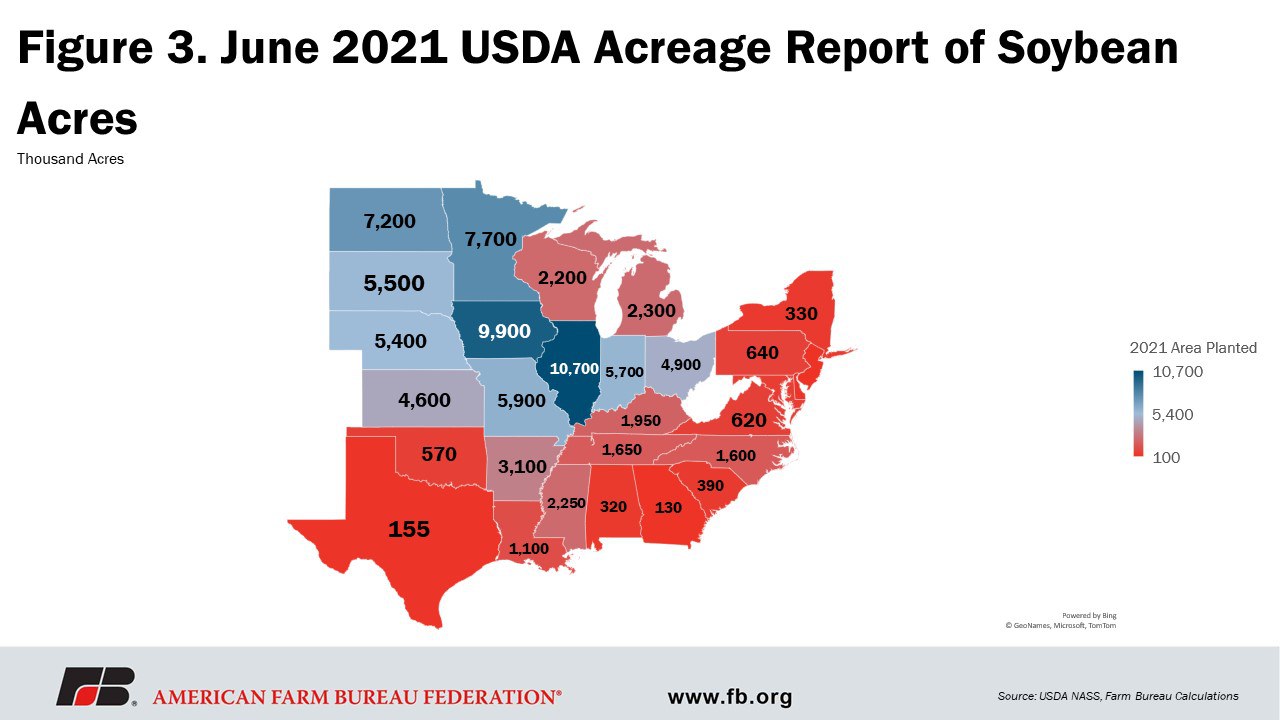
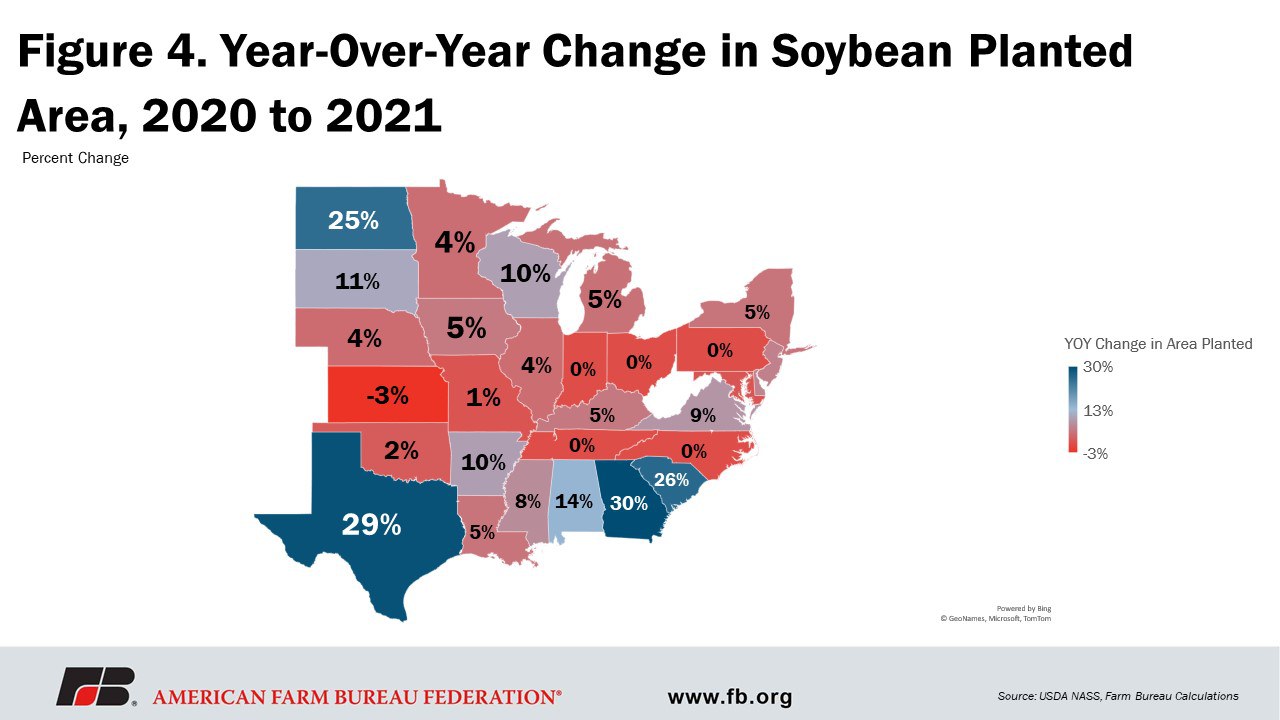
2021 Wheat Planted Acres
Analysts’ expectations for wheat acres were just under 46 million acres ahead of the June 30 report – below the 46.7 million acres yesterday’s report indicated. Kansas has the most all-wheat planted acres at 7.3 million acres, up 11% from 2020, when farmers in the state planted 6.6 million acres. Behind Kansas, North Dakota farmers have planted 6.7 million acres, up 2% from 2020, when they planted 6.6 million acres. Texas has the third-largest amount of wheat acres, planting 5.6 million acres, up 14% from 2020, when Texas farmers planted 4.9 million acres of wheat. Mississippi has the largest increase in wheat plantings -- 125% -- going from 40,000 acres in 2020 to 90,000 acres this year. Wisconsin is increasing wheat planted acres by 88%, going from 160,000 acres planted in 2020 to 300,000 acres in 2021. Arkansas increased wheat planted acres by 52%, the third-largest increase, going from 145,000 acres in 2020 to 220,000 acres in 2021.
Figures 5 and 6 highlight USDA’s 2021 wheat acres planted and the year-over-year change from 2020.
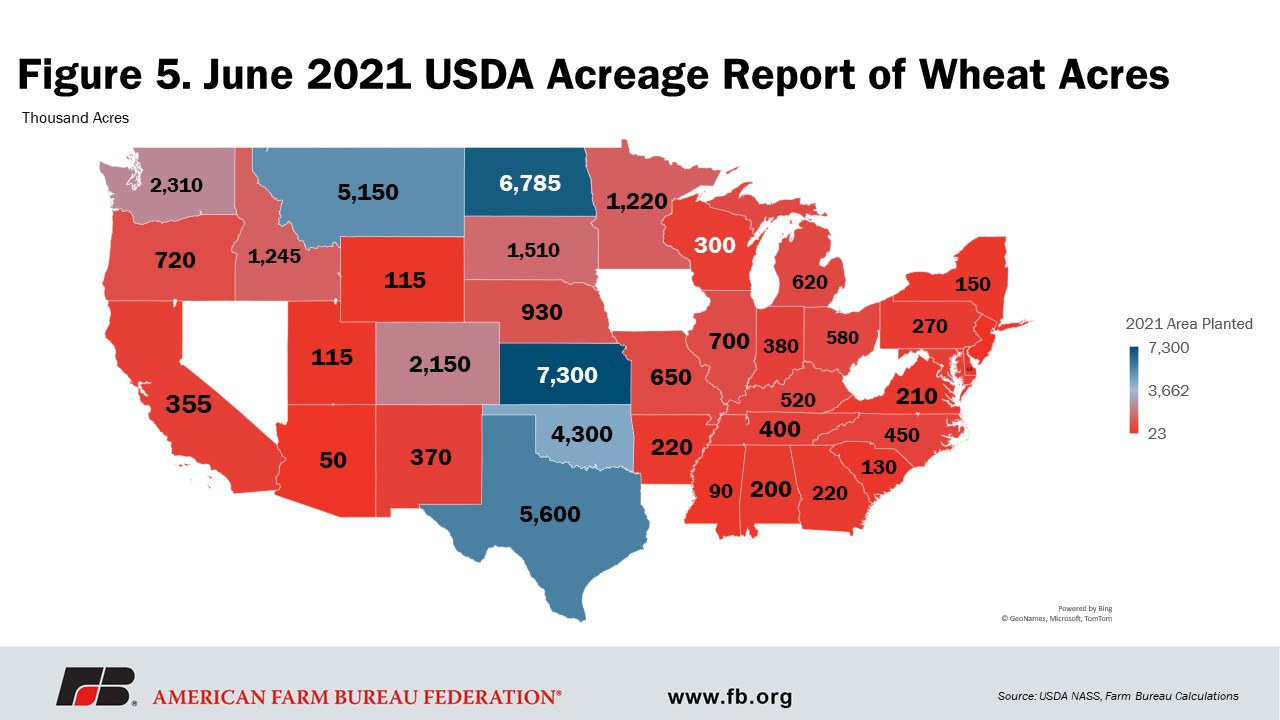
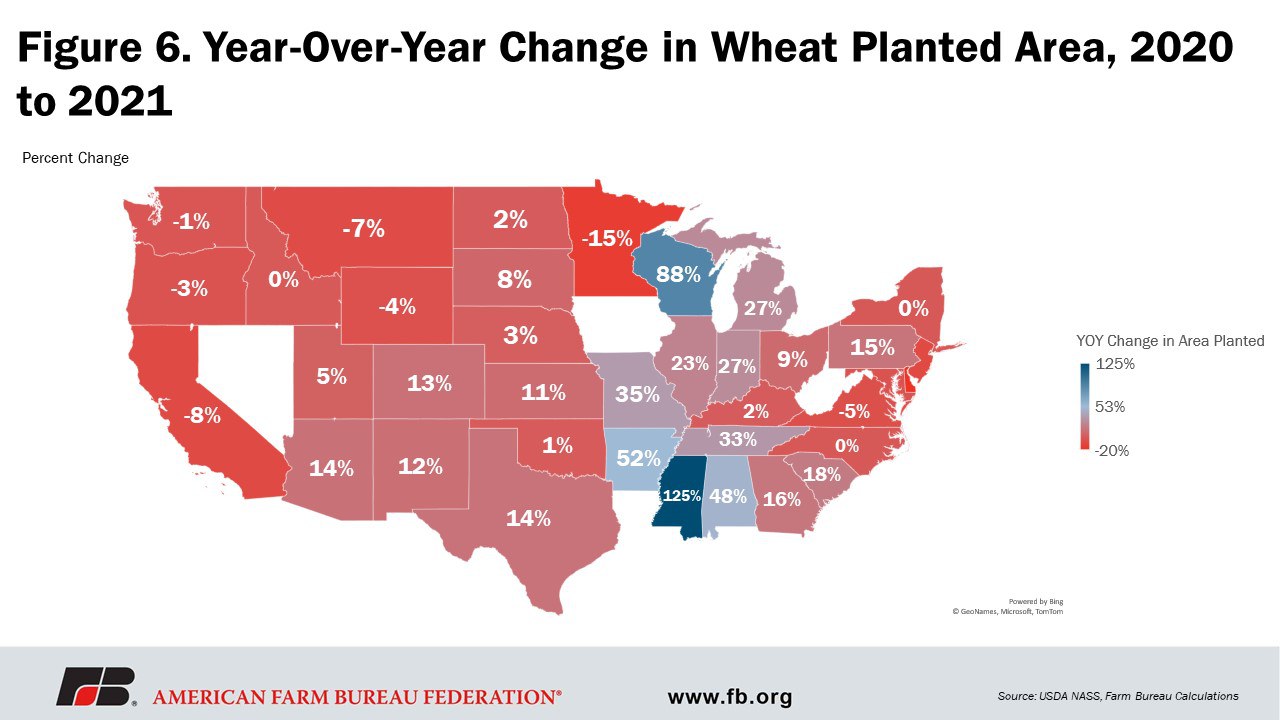
2021 Cotton Planted Acres
Analysts in the private sector anticipated the June 30 Acreage report for cotton would settle around 11.8 million acres, and the USDA report largely fell in line with that estimate, landing slightly lower. Texas is leading the way in the largest amount of all-cotton acres with 6.7 million acres of cotton planted, down 2% from 2020, when Texas farmers planted 6.8 million acres. Second behind Texas is Georgia, planting 1.2 million acres in 2021, up 1% from 2020 when 1.1 million acres were planted. The third-largest all-cotton planted acres is in Mississippi, where 490,000 acres of cotton are planted, down 8% compared to 2020 when Mississippi farmers planted 530,000 acres. The largest change in acres occurs in Kansas, where farmers are planting 38% fewer cotton acres in 2021 than in 2020, moving from 195,000 acres to 120,000 acres. Farmers in Louisiana and New Mexico also significantly decreased their cotton planted acres, dropping down by 29% and 27%, respectively. Missouri is increasing cotton acres by the largest amount, growing 32%, from 295,000 acres in 2020 to 390,000 acres in 2021.
Figures 7 and 8 highlight USDA’s 2021 cotton acres planted and the year-over-year change from 2020.
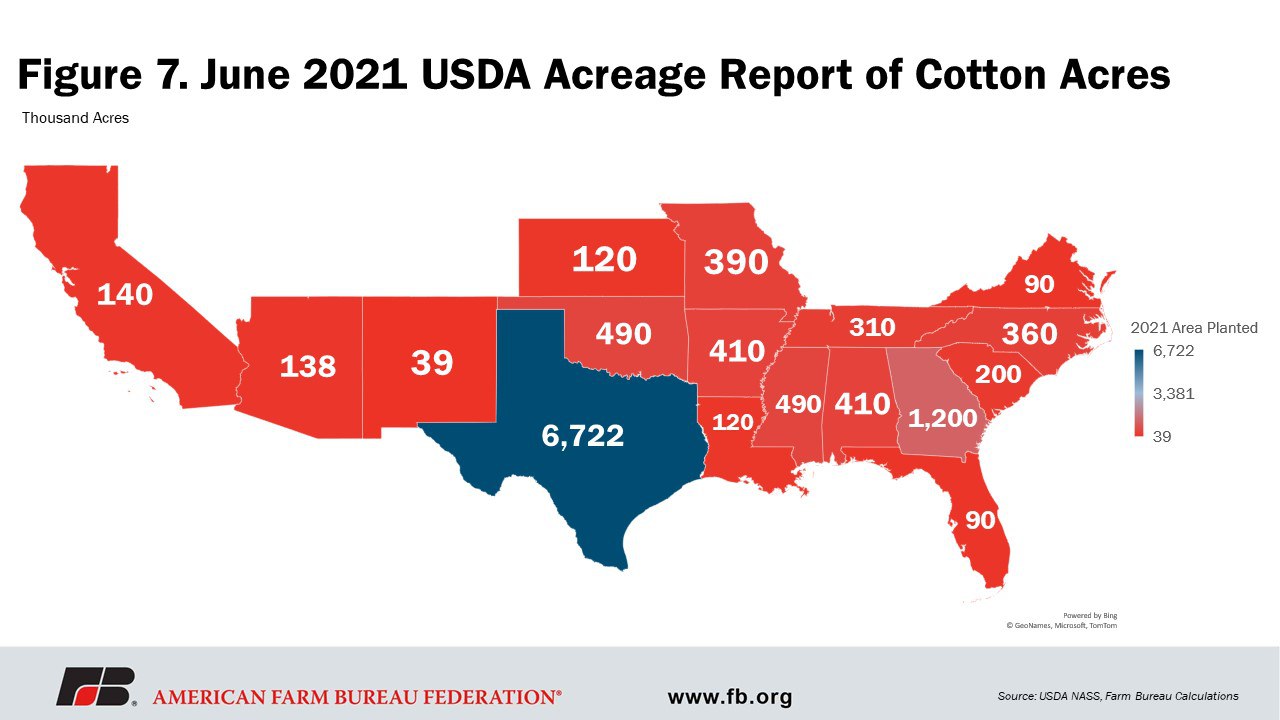
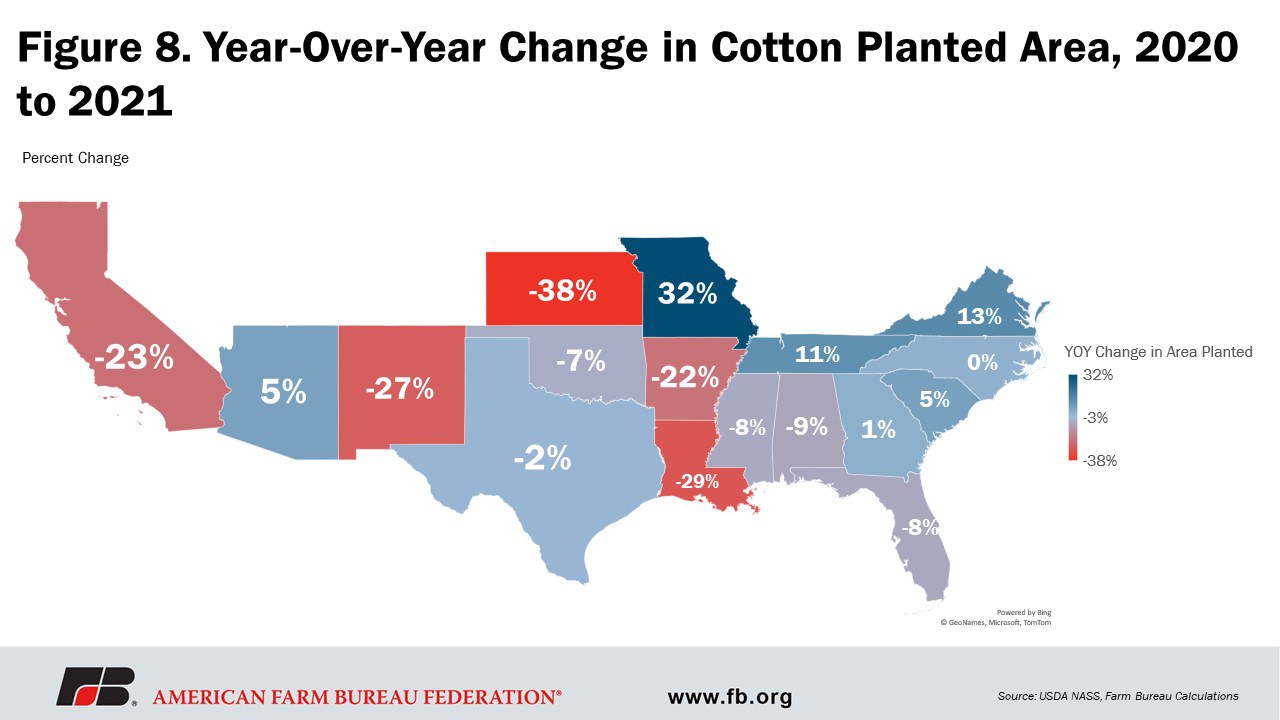
Summary
USDA currently expects 92.7 million acres of corn, 87.6 million acres of soybeans, 46.7 million acres of wheat and 11.7 million acres of cotton for the 2021/22 crop year. Farmers and market analysts have been closely watching market trends since intended planted acres were first reported in the March Prospective Planting report. Corn and soybean futures prices have risen 23% and 16%, respectively, compared to USDA’s estimates for the 2020/21 marketing year. The incentive to plant either commodity has been strong and fueled expectations that farmers were likely to increase acreage for both. The June Acreage report indicates farmers shifted toward corn planted acres, but as soybean expectations are nearly unchanged, it indicates acres were brought back into production to take advantage of current commodity prices. Attention will shift to monitoring weather impacts, which will determine crop quality and overall supply quantities. Drought in the West and moving East and heavy rains in the South and along the Mississippi Delta region could cause current supply estimates to drop. Given current demand expectations that won't be updated until July 12 in the World Agricultural Supply and Demand Estimates, market indicators imply prices will hover around current higher levels, despite the second-largest planting record of combined corn and soybean acreage.
